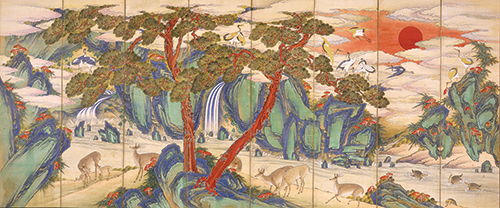
Do you ever wonder why people get up so early on Saturday mornings, when they could be sleeping? While most spend their time hiking or visiting the local farmers markets, this Saturday some lucky and dedicated community members will jump out of bed, fuel up at the nearest coffee chain and come to Portland State’s First Saturday Lecture.
PSU’s Institute for Asian Studies will host “The Allure of Painted Poetry: East Asian Screens,” a lecture and presentation by Dr. Charles Lachman, former head curator of Asian art at the Jordan Schnitzer Museum.
Lachman is currently the director of graduate studies and head of the Department of History of Art and Architecture at the University of Oregon, where he continues to study East Asian art and history.
Katherine Morrow, the program administrator for the institute, spoke highly of Lachman.
“He came very highly recommended by the Portland Art Museum as an expert in Korean art,” she said.
Lachman’s fascination with East Asia began in high school.
“In college, I ended up majoring in world religions, which allowed me to further explore these interests,” Lachmann said. “I was also interested in art from a fairly young age, and gradually these two interests came together as I began to focus my studies on Asian art, especially Chinese art and Buddhist art.”
Lachman suspects that he may have been enticed by more than just the art, however.
“I also really love just about all Asian food, which I suspect also helped to influence my studies,” he said.
With his lecture, Lachman plans “to introduce the audience to the folding screen as a unique type of art object, so to speak, that conceptually is very different [from] most forms of painting,” he said.
Dating back as far as the third century, paper screens used in Japan and China depicted scenes of war, peace and everyday life. In the Chinese tradition, they have long been serious, stationary pieces, usually serving as partitions.
The Japanese, however, have several terms and uses for their paper screens, demonstrating how varied different East Asian screens can be.
“I will also try to illustrate some of the ways in which the arts of China, Japan and Korea are very deeply interrelated yet nonetheless culturally unique,” Lachman said.
The institute’s program began nearly 10 years ago as a collaboration between PSU and Portland’s Lan Su Chinese Garden. This lecture will be part of the Saturday series, a monthly lecture series covering various topics.
Last year, the institute’s lectures covered topics from the Chinese-American experience during World War II to Chinese plants that have influenced the gardening world. This year’s theme is “Insights Along the Zig Zag Bridge.”
There is a misconception that some Asian cultures believe that ghosts can only move in straight lines: Some westerners believe this is why bridges typically zigzag in Chinese and Japanese gardens.
These bridges are attractive and create new and interesting views of a garden or waterway. They are beautiful for the sake of being beautiful.
“[They] make one slow down to appreciate what is there at each and every turn,” Morrow said of zigzag bridges. “The viewpoint when you turn will be different.”
“The Allure of Painted Poetry: East Asian Screens,” a lecture by Dr. Charles Lachman
Saturday, Feb. 2, 9:30–11 a.m.
Urban Building, room 250
Free and open to the public
Traditionally, the lecture series has focused on Chinese art and culture because it was developed by Lan Su Chinese Garden volunteers who created their own professional development group.
Returning to the theme of the zigzag bridge, Morrow said that the lectures this year have “turned a corner…to look at Korean and Japanese art.”
The next few lectures will take on more of a Korean theme. There will even be a two-part concert series at the end of February that will feature Japanese, Chinese and Korean singers.
Another reason the institute selected Lachman as a speaker is the subject matter of his lecture: It is the perfect segue to the lecture’s forthcoming topics, including the Portland Art Museum’s unveiling of a mysterious Korean screen next month.
“We wanted a teaser to help draw people in,” Morrow said. “Most of the people who come to these lectures are interested in Chinese art, but this is a good way to expose them to something different.”
Lachman’s goal for the lecture is simply to change people’s perspectives.
“If people think about folding screens a little bit differently when they leave than they did when they came in, I will consider the talk a success,” Lachman said.
